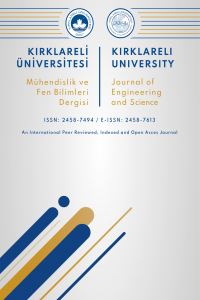KİRLETİCİ PARAMETRELERİN ATMOSFERDEKİ YOĞUNLUKLARINA DAİR SINIR DEĞERLER: ÖRNEK ÇALIŞMA MUŞ İLİNİN HAVA KİRLİLİĞİ
Hava Kirliliği, PM10, SO2, sınır değer
Limit Values for the Density of Pollutant Parameters in the Atmosphere: Sample Study Air Pollution of Mus Province
Air Pollution, PM10, SO2, limit value,
___
- [1] WHO, Health topics, Air pollution. https://www.who.int/health-topics/air-pollution, (Erişim Tarihi: 20.03.2022)
- [2] TMMOB Çevre Mühendisleri Odası., Hava Kirliliği Raporu-2018. TMMOB Çevre Mühendisleri Odası, 2019.
- [3] Garipağaoğlu, N., Türkiye’de Hava Kirliliği Sorununun Coğrafi Bölgelere Göre Dağılımı. Doğu Coğrafya Dergisi. 9 57–77, 2016.
- [4] Çiçek, İ., Türkoğlu, N. ve Gürgen, G. Ankara’da Hava Kirliliğinin İstatistiksel Analizi. Fırat Üniversitesi Sosyal Bilimler Dergisi. 14 (2), 1–18, 2004.
- [5] Zencirci, S.A. ve Işıklı, B. Hava Kirliliği. ESTÜDAM Halk Sağlığı Dergisi. 2 (2), 24–36, 2017.
- [6] Mage, D., Ozolins, G., Peterson, P., Webster, A., Orthofer, R., Vandeweerd, V. ve ark., Urban air pollution in megacities of the world. Atmospheric Environment. 30 (5), 681–686, 1996.
- [7] The Organization for Economic Co-operation and Development (OECD), OECD Environmental Outlook to 2050. OECD Publishing, 2012.
- [8] Sezer Turalıoğlu, F., Nuhoğlu, A. ve Bayraktar, H., Impacts of some meteorological parameters on SO2 and TSP concentrations in Erzurum, Turkey. Chemosphere. 59 (11), 1633–1642, 2005.
- [9] Cavkaytar, Ö., Soyer, Ö.U. ve Şekerel, E., Türkiye’de Hava Kirliliğinden Kaynaklanan Sağlık Sorunları. Hava Kirliliği Araştırmaları Dergisi. 2 (4), 105–111, 2013.
- [10] Kim, K.-H., Kabir, E. ve Kabir, S., A review on the human health impact of airborne particulate matter. Environment International. 74 136–143, 2015.
- [11] Hooyberghs, J., Mensink, C., Dumont, G., Fierens, F. ve Brasseur, O.A, neural network forecast for daily average PM10 concentrations in Belgium. Atmospheric Environment. 39 (18), 3279–3289, 2005.
- [12] Unal, Y.S., Toros, H., Deniz, A. ve Incecik, S., Influence of meteorological factors and emission sources on spatial and temporal variations of PM10 concentrations in Istanbul metropolitan area. Atmospheric Environment, 45 (31), 5504-5513.
- [13] Nava, S., Lucarelli, F., Amato, F., Becagli, S., Calzolai, G., Chiari, M. ve ark., Biomass burning contributions estimated by synergistic coupling of daily and hourly aerosol composition records. Science of The Total Environment. 511 11–20, 2015.
- [14] T.C. Sağlık Bakanlığı Halk Sağlığı Genel Müdürlüğü. Hava Kirliliği ve Sağlık Etkileri. https://hsgm.saglik.gov.tr/tr/cevresagligi-ced/ced-birimi/hava-kirlili%C4%9Fi-ve-sa%C4%9Fl%C4%B1k-etkileri.html#:~:text=Partik%C3%BCl%20boyutu%20ile%20sa%C4%9Fl%C4%B1k%20%C3%BCzerindeki,alveollerden%20intrakapiller%20aral%C4%B1%C4%9Fa%20diff%C3%BCze%20olmaktad%C4%B1r. (Erişim Tarihi: 15.03.2022)
- [15] Turgut, D. ve Temiz, İ., Time Series Analysis and Forecasting For Air Pollution In Ankara: A Box-Jenkins Approach. Alphanumeric Journal. 3 (2), 131–138, 2015.
- [16] Babin, S., Burkom, H., Holtry, R., Tabernero, N., Davies-Cole, J., Stokes, L. ve ark., Medicaid patient asthma-related acute care visits and their associations with ozone and particulates in Washington, DC, from 1994-2005. International Journal of Environmental Health Research. 18 (3), 209–221, 2008.
- [17] Tecer, L.H., Tomac, N., Karaca, F., Kaplan, A., Tuncer, T. ve Aydin, H., The evaluation of the effect of air pollution on the health status of children in Zonguldak City, Turkey. International Journal of Environment and Pollution. 39 (3–4), 352–364, 2009.
- [18] Thi Nguyen, H. ve Kim, K.-H., Evaluation of SO2 pollution levels between four different types of air quality monitoring stations. Atmospheric Environment. 40 (36), 7066–7081, 2006.
- [19] Santosa, S.J., Okuda, T. ve Tanaka, S., Air Pollution and Urban Air Quality Management in Indonesia. CLEAN – Soil, Air, Water. 36 (5–6), 466–475, 2008.
- [20] Park, S.U., In, H.J., Kim, S.W. ve Lee, Y.H., Estimation of sulfur deposition in South Korea. Atmospheric Environment. 34 (20), 3259–3269, 2000.
- [21] WHO. Air quality guidelines for Europe. World Health Organization. Regional Office for Europe, 2000.
- [22] T.C. Çevre, Şehircilik ve İklim Değişikliği Bakanlığı. Hava Kalitesi İzleme İstasyonları Web Sitesi, 2022.
- [23] Kartal, S. ve Özer, U., Determination and Parameterization of Some Air Pollutants as a Function of Meteorological Parameters in Kayseri, Turkey. Journal of the Air & Waste Management Association. 48 (9), 853–859, 1998.
- [24] Akdi, Y., Okkaoğlu, Y., Gölveren, E. ve Yücel, M.E., Estimation and forecasting of PM10 air pollution in Ankara via time series and harmonic regressions. International Journal of Environmental Science and Technology. 17 (8), 3677–3690, 2020.
- [25] Koşan, Z., Kavuncuoğlu, D., Çalikoğlu, E.O. ve Yerli̇, E.B., Evaluation of air pollution by PM10 and SO2 levels in Erzurum province, Turkey: Descriptive study. Journal of Surgery and Medicine. 2 (3), 265–268, 2018
- [26] Das, A.V. ve Basu, S., Environmental and Air Pollution Factors Affecting Allergic Eye Disease in Children and Adolescents in India. International Journal of Environmental Research and Public Health. 18 (11), 5611, 2021.
- [27] Xue, W., Zhan, Q., Zhang, Q. ve Wu, Z., Spatiotemporal Variations of Particulate and Gaseous Pollutants and Their Relations to Meteorological Parameters: The Case of Xiangyang, China. International Journal of Environmental Research and Public Health. 17 (1), 136, 2020.
- [28] Li, R., Wang, Z., Cui, L., Fu, H., Zhang, L., Kong, L. ve ark., Air pollution characteristics in China during 2015–2016: Spatiotemporal variations and key meteorological factors. Science of The Total Environment. 648 902–915, 2019.
- [29] Garipağaoğlu, N., Türkiye Ortam Sorunları Coğrafyası: İstanbul, 2011.
- [30] Şahin, C., Hava Kirliliği ve Hava Kirliliğini Etkileyen Doğal Çevre Faktörleri. Atatürk Kültür Dil ve Tarih Yüksek Kurumu Coğrafya Araştırmaları Dergisi. 1 (1), 27–45, 1989.
- ISSN: 2458-7494
- Yayın Aralığı: Yılda 2 Sayı
- Başlangıç: 2015
- Yayıncı: Kırklareli Üniversitesi
NADİR TOPRAK ELEMENTLERİNİN UYGULAMA ALANLARI
GÖZLÜK CAMLARINDA IŞIK GEÇİRGENLİK ÖZELLİKLERİ
Faz Değiştiren Malzemeler: Çeşitleri, Özellikleri ve Binalarda Kullanımları
Fatih Selim BAYRAKTAR, Ramazan KÖSE
BİYOMEKANİK ANALİZDE YÜK KALDIRMA HAREKETİ YAKALAMA YÖNTEMLERİ VE ÖRNEK UYGULAMA
Melih CANLIDİNÇ, Mustafa GÜLEŞEN
ENTEGRE GÜNEŞ KOMBİNE ÇEVRİM SANTRALİNİN YAPISI VE ENERJİ ÜRETİMİNİN DEĞERLENDİRİLMESİ
TORBALAMA KARAR AĞACI TABANLI MAKINE ÖĞRENIMI KULLANARAK GÜNEŞ IŞINIMI TAHMİNİ
TEK VE ÇİFT KARE KUYU TELLERİNDE ELEKTRİK ALAN VE MANYETİK ALAN’IN ELEKTRONİK ÖZELLİKLERE ETKİSİ
BAZI FARK DENKLEMLERİNİN AYARLANMIŞ JACOBSTHAL-PADOVAN SAYILARI İLE İLİŞKİLİ TAM ÇÖZÜMLERİ
ÇOKLU KUANTUM TEL KUYULARINDA ELEKTRİK ALAN VE MANYETİK ALAN’IN ELEKTRONİK ÖZELLİKLERE ETKİSİ
